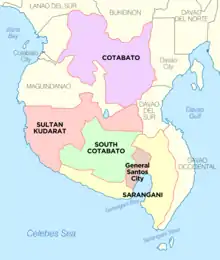Koronadal
Koronadal, officially the City of Koronadal (Hiligaynon: Dakbanwa sang Koronadal; Maguindanaon: Ingud nu Koronadal), and also known as Marbel, is a 3rd class city and capital of the province of South Cotabato, Philippines. According to the 2015 census, it has a population of 174,942 people. [3]
Koronadal
Marbel | |
|---|---|
| City of Koronadal | |
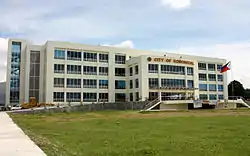 City Hall | |
 Seal | |
Nickname(s):
| |
| Motto(s): Kanami Koronadal, Kanami Guid | |
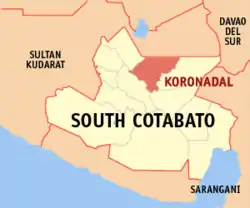 Map of South Cotabato with Koronadal highlighted | |
OpenStreetMap 
| |
.svg.png.webp) Koronadal Location within the Philippines | |
| Coordinates: 6°30′N 124°51′E | |
| Country | |
| Region | Soccsksargen (Region XII) |
| Province | South Cotabato |
| District | 2nd District |
| Founded | January 10, 1939 (as Marbel Settlement District) |
| Chartered | August 18, 1947 |
| Cityhood | October 8, 2000 |
| Barangays | 27 (see Barangays) |
| Government | |
| • Type | Sangguniang Panlungsod |
| • Mayor | Eliordo "Bebot" U. Ogena |
| • Vice Mayor | Peter B. Miguel |
| • Representative | Ferdinand L. Hernandez |
| • Electorate | 108,358 voters (2019) |
| Area | |
| • Total | 277.00 km2 (106.95 sq mi) |
| Elevation | 333 m (1,093 ft) |
| Population | |
| • Total | 174,942 |
| • Density | 630/km2 (1,600/sq mi) |
| • Households | 42,473 |
| Demonym(s) | Koronadaleños; Marbeleños |
| Economy | |
| • Income class | 3rd city income class |
| • Poverty incidence | 22.41% (2015)[4] |
| • Revenue | ₱720,036,615.06 (2016) |
| Time zone | UTC+8 (PST) |
| ZIP code | 9506 |
| PSGC | |
| IDD : area code | +63 (0)83 |
| Climate type | tropical rainforest climate |
| Native languages | Hiligaynon Cebuano Maguindanao Blaan Tagalog |
| Website | koronadal |
It is the capital of the province of South Cotabato and regional administrative center of SOCCSKSARGEN (Region XII).[5]
Koronadal City is one of the Planned Cities of the Philippines that were signed by congress on 1965. It became a component city of South Cotabato by virtue of Republic Act 8803 dated October 8, 2000.[6]
Koronadal City is one of the two cities in Mindanao where majority of the citizens are ethnic Hiligaynons, who comprise 95% of the city's population, the other being Tacurong City, Sultan Kudarat.[6] In 2003 and 2005 the city was recognized as "Most Competitive City" in the small-city category, and in 2005 and 2006 as the most business friendly city in Mindanao.[6]
History

The settlement of Koronadal and its creation as a municipality by virtue of Executive Order No. #82 dated August 18, 1947 was marked by a rapid initial development, so that when the province of South Cotabato was created under Republic Act No. 4849 on July 18, 1966, it easily became the capital town. In the past, the place was populated by Blaan people and Maguindanaos. The word Koronadal is believed to have been derived from two Blaan words- kalon meaning cogon grass, and nadal or datal meaning plain, which aptly described the place to the natives.[7] On the other hand, Marbel, which is another name for the poblacion, is a Blaan term marb el which means "murky waters" referring to a river, now called the Marbel River.
Koronadal City used to comprise the area extending from the banks of Buluan Lake to the north to Barangay Polonoling in the municipality of Tupi, South Cotabato to the south from Quezon mountain range to the northeast to the municipality of T'boli, South Cotabato to the southeast.
It was on August 18, 1947 when President Manuel Roxas signed the Executive Order creating the municipalities in the entire province of Cotabato, one of which was Marbel (now Koronadal). The same executive order likewise mandated the official function of the municipal government which began after the qualification and election of the first set of municipal officials.
The municipal government of Koronadal began its official function on January 1, 1948 with an approved Annual Estimated Budget of P30,000.00. The land area of the municipality by then was comparable with the Province of Bata-an embracing the present municipalities of Tampakan, Tupi, Banga, Lake Sebu, Surallah, T'boli, South Cotabato, Santo Niño, Norala, and Isulan.
Municipal Council Resolution No. 32, Series of 1948 mandated and proclaimed January 10 of each year as the Municipal Town Fiesta commemorating the foundation of Marbel Settlement District of the National Land Settlement.
Koronadal was converted into a component city of South Cotabato, now officially known as the City of Koronadal by virtue of Republic Act 8803 on October 8, 2000. At present, Koronadal City is a fast-developing growth center composed of twenty-seven (27) barangays including the four (4) zones in the poblacion. Being the capital city of South Cotabato, it is the center of the province in terms of political, cultural and socio-economic activities.
By virtue of Executive Order No. 304 signed by then President Gloria Macapagal-Arroyo, Koronadal City was named as the Regional political and socio-economic center of SOCCSKSARGEN on March 30, 2004. Regional departments, bureaus and offices were ordered to move from Cotabato City, the former Regional Center of the Region.[5]
Geography
Koronadal is located in the central part of southern Mindanao, in a gently sloping plain surrounded by low mountains.[8]
Barangays

Koronadal City is politically subdivided into twenty-seven Barangays with four zones in the Poblacion area. Eight of which are on the Urban area while the remaining nineteen are located on the Rural area.
- General Paulino Santos (Barrio Uno)
- Morales
- Santa Cruz
- Santo Niño (Barrio Dos)
- Zone I (Poblacion Zone 1)
- Zone II (Poblacion Zone 2)
- Zone III (Poblacion Zone 3)
- Zone IV (Poblacion Zone 4)
Rural
- Assumption (Bulol)
- Avanceña (Barrio Tres)
- Cacub
- Caloocan
- Carpenter Hill
- Concepcion (Barrio Sais)
- Esperanza
- Mabini
- Magsaysay
- Mambucal
- Namnama
- New Pangasinan (Barrio Kwatro)
- Paraiso
- Rotonda
- San Isidro
- San Jose (Barrio Singko)
- San Roque
- Saravia (Barrio Otso)
- Topland (Barrio Syete)
Climate
The climate of Koronadal is mild and sub-tropical, belonging to climate Type IV. The place is typhoon free. Rainy months are from June to October.[8]
| Climate data for Koronadal City, South Cotabato | |||||||||||||
|---|---|---|---|---|---|---|---|---|---|---|---|---|---|
| Month | Jan | Feb | Mar | Apr | May | Jun | Jul | Aug | Sep | Oct | Nov | Dec | Year |
| Average high °C (°F) | 31 (88) |
31 (88) |
32 (90) |
32 (90) |
31 (88) |
30 (86) |
29 (84) |
30 (86) |
30 (86) |
30 (86) |
30 (86) |
31 (88) |
31 (87) |
| Average low °C (°F) | 23 (73) |
23 (73) |
23 (73) |
24 (75) |
24 (75) |
24 (75) |
24 (75) |
24 (75) |
24 (75) |
24 (75) |
24 (75) |
23 (73) |
24 (74) |
| Average precipitation mm (inches) | 64 (2.5) |
45 (1.8) |
59 (2.3) |
71 (2.8) |
140 (5.5) |
179 (7.0) |
192 (7.6) |
198 (7.8) |
163 (6.4) |
147 (5.8) |
113 (4.4) |
66 (2.6) |
1,437 (56.5) |
| Average rainy days | 12.2 | 10.3 | 12.7 | 15.7 | 26.0 | 27.4 | 28.1 | 28.2 | 26.0 | 26.7 | 22.9 | 16.6 | 252.8 |
| Source: Meteoblue (modeled/calculated data, not measured locally)[9] | |||||||||||||
Demographics
|
| |||||||||||||||||||||||||||||||||||||||||||||
| Source: Philippine Statistics Authority [3] [10] [11][12] | ||||||||||||||||||||||||||||||||||||||||||||||
Language
The main language of the city is Hiligaynon. Tagalog, Ilocano and Cebuano are also widely spoken. While Maranao, English, and Arabic are also heard in the city.[13]
Religion
Churches and Mosques in Koronadal:
- Christ the King Cathedral (San Antonio de Padua Parish Church), Downtown Koronadal
- San Guillermo Parish Church, Morales
- Sagrada Familia Parish Church, San Jose
- Sacred Heart Parish Church, General Paulino Santos
- Our Lady of the Holy Rosary Parish Church, Santa Cruz
- Passionist Seminary, Paraiso
- Our Lady of Perpetual Help Seminary, Santo Niño
- Seventh-Day Adventist Church, Downtown Koronadal
- Iglesia Ni Cristo, Downtown Koronadal
- Iglesia Ni Cristo, Morales
- Members Church of God International, Downtown Koronadal
- The Church of Jesus Christ of Latter-day Saints, Downtown Koronadal
- Koronadal Grand Mosque, Downtown Koronadal
- Balik-Islam Mosque, Morales
- Engineer Buisan Mosque, Downtown Koronadal
Culture
B’laan culture
The B'laan people are one of the indigenous peoples of the Southern Philippine island of Mindanao. Another tribe called the Maguindanao also inhabits the same area. The two tribes consider themselves to be brothers and sisters. Long ago, an Arab male (ancestral brother) married a B'laan female (ancestral sister) and through this marriage union, Islam infiltrated Southern Mindanao so that when the Spaniards arrived, their attempts to establish Catholicism were unsuccessful in the south. Eventually the B'laan and the Maguindanao became trade partners with the B'laan settling in the mountains and the Maguindanao settling along the coastal areas. From that time until now, the B'laans have been producing rice, vegetables, livestock, and rainforest products. The original religion of the Blaan is Animist. Presently, only 5% of the 8,000 B'laan tribal people are considered to be evangelical.
Catholic culture
The Catholic Filipinos make up the great majority (over 70%) of the Southern Philippine population. They are relatively newcomers to the area; the first wave of Christian migrants came in the seventeenth century when the Spaniards sought to populate Zamboanga, Jolo, Dapitan and other areas by encouraging people from Luzon and the Visayas to settle there. In the nineteenth century Spanish policy found considerable success in encouraging migrations to Iligan and Cotabato.
The Americans continued this pattern during their colonial administration. In 1913 the American colonial government provided resources for the establishment of agricultural colonies in Mindanao. By the time the Philippine Commonwealth was established, Mindanao had become a veritable frontier. Wave upon wave of migrants poured into the region, chiefly among them the Hiligaynons, Cebuanos, Ilocanos, and Kapampangans. These people did much to clear the virgin areas of Mindanao and open them to extensive agriculture and industry.
Muslim culture
The cultural diversity of the region is the result of a large influx of migrants from the north over a long period of the region's history. Found here are three main cultural groups: the early Filipinos who belong to various indigenous tribes living in the highlands and remote areas of Mindanao, the Muslim Filipinos who were early converts to Islam and who regard the region as their traditional homeland, and the Catholic Filipinos who founded settlements and communities in the course of their migrations from other parts of the country.
Tourism
- Bong Gumne de Muhon
- Damweng Dmatal
- El Gawel Zoo
- Mambucal Hot Spring
- Saravia Falls
- Siok Falls
- Supon Falls
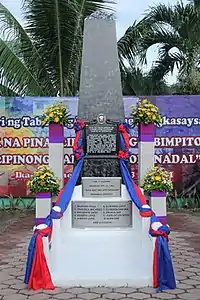
Parks
- CIOFF Park
- Freedom Park
- Paraiso Verde Water Park
- Rizal Park
Museums and Shrines
- Albert Morrow and Santiago Odi Memorial Shrine
- Filipino – Japanese Memorial Shrine
- General Paulino Santos Roundball
- Historical Marker of the Seventeen Martyrs
- Notre Dame of Marbel University Library and Museum
- South Cotabato Community Museum
- Tantoco Memorial Showcase
Retail and commercial
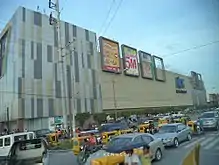
Home for many shopping malls in South Cotabato, it serves as one of the tourism economic activity of the city. Koronadal is considered as the main shopping hub for nearby municipalities and provinces.
| # | Mall | Opening Date | Location | Status |
|---|---|---|---|---|
| 1 | KCC Mall of Marbel | 1947 as Koronadal Commercial Center
1989 as KCC Shopping Center 2000 as KCC Mall of Marbel |
General Santos Drive corners Aquino Street, Posadas Street and Osmeña Street, Barangay Zone II | Open |
| 2 | Mall of Ace Centerpoint | 1973 as Ace Commercial
1999 as Ace Centerpoint 2020 as Mall of Ace Centerpoint |
General Santos Drive corners Roxas Street, Posadas Street and Osmeña Street, Barangay Zone II | Ongoing Expansion |
| 3 | FitMart Mall of Marbel | December 1, 2002 | General Santos Drive, Barangay Santo Niño | Closed, acquired by the Gaisano group of company[14] |
| 4 | Gaisano Grand Koronadal | December 8, 2011 | General Santos Drive, Barangay Santo Niño | Open |
| 5 | Unitop Koronadal | May 22, 2016 | Osmeña Street, Barangay Zone II | Open |
| 6 | CityMall Koronadal | November 8, 2017 | General Santos Drive corner Lacson Street, Barangay Morales | Open |
| 7 | Robinsons Place Koronadal | 2022 | General Santos Drive, Barangay Zone II | Under Construction |
| 8 | SM City Koronadal | 2023 | General Santos Drive, Barangay Santo Niño | Land Acquisition |
Events
Koronadal also hosted an international activity called Pyesta Kalon Datal: Koronadal International Folkloric Festival in coordination with Conseil international des organisations de festivals de folklore et d'arts traditionnels or the International Council of Organizations of Folklore Festivals and Folk Art (CIOFF) last August 10 to 18, 2015[15] and August 11 to 18, 2018[16] and several national activities such as the Palarong Pambansa in 1996 with General Santos and solo in 2007, Mindanao Business Forum, and National Schools Press Conference. On June 12, 2009, President Gloria Macapagal-Arroyo together with Defense Secretary Gibo Teodoro celebrated the 111th Independence Day in the city, which marks a significant and historic event in the history of Koronadal.
Festivals
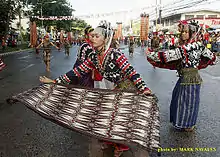
- Hinugyaw Festival (January 8–10) – is the festival that marks the foundation anniversary of Koronadal as a municipality. It shows the festive spirit of the people of Koronadal with street dancing and night beer parties in the streets of Koronadal among other worthwhile activities.
- T'nalak Festival (July 16–18) – a festival that celebrates South Cotabato's Tboli tribe with colorful abaca cloth created and woven by the women from their tribe. It symbolizes the blending of culture, strength and unity of the various ethnic groups living in the province. They have Dayana Civic Parade which highlighted by a float and cheer dance competition. They perform on the streets of the city showcasing native costumes of Blaan, Tboli and other tribal groups in Mindanao.
- Cityhood Charter Anniversary (October 8) – celebrates the cityhood of Koronadal highlighted by "Negosyo Festival" showcasing the vibrancy of business and other economic enterprises in the City of Koronadal; consumers enjoy month-long citywide grand sale as participating business establishments give discounts of up to 70% off their regular prices on goods or services.
Medical facilities
Health Facilities in Koronadal are also widely distributed to all Marbeleños.
Hospitals in the City of Koronadal:
- South Cotabato Provincial Hospital, Aguinaldo Street
- Allah Valley Medical Specialists’ Center, General Santos Drive
- Dr. Arturo P. Pingoy Medical Center, General Santos Drive
- Socomedics Medical Center, Judge Alba Street
Education
Education in Koronadal is widely distributed to all Koronadaleños. As of for the school year 2009–2010, there are 95 primary and elementary schools in the city, both in public and private schools; while there are 17 secondary schools, both in public and private schools.
There are two universities in the city:
- Notre Dame of Marbel University
- University of the Philippines Manila – Koronadal School of Health Sciences
While other colleges are also vibrant in the education business. The list below shows the tertiary level schools present in the city:
- St. Alexius College
- Green Valley College Foundation
- Ramon Magsaysay Memorial College
- Holy Child College of Information Technology, Inc.
- Regency Polytechnic College
- ACLC College of Marbel
- King's College of Marbel, Inc.
- SITE Dizon
- STI College Koronadal
- Goldenstate College Marbel
- Marbel Institute of Technology College
- Marvelous College of Technology, Inc.
- Southern Philippines Technical Institute, Inc.
- SouthPhil Institute of Technology, Inc.
The list below shows some prominent secondary and elementary schools present in the city:
- Philippine Science High School SOCCSKSARGEN Region Campus
- Notre Dame of Marbel University - Integrated Basic Education Department
- Notre Dame - Siena School of Marbel
- Notre Dame of San Jose
- Dolores Peneza Montessori Academy Inc. (formerly Casa Dolores Montessori School, Inc)
- St Alexius College - Integrated School Department
- Koronadal National Comprehensive High School
- Koronadal Southern Elementary School (Chinese School)
- Koronadal International School
- Maryland School
- King's College of Marbel, Inc.
- Marymount School
Koronadal is also home to one seminary, the Our Lady of Perpetual Help Seminary or locally known as OLPHS.
Notable people
- Christian Perez - darts player
- Jason Sabio - footballer who plays for Kaya
- Kenneth Duremdes - PBA basketball player
- Ernestine Tiamzon - DLSU Lady Spiker
- Lovely Abella - GMA 7 Artist
- Cesar "Saro" Bañares, Jr. - member of folk rock band Asin
Sister cities
References
- City of Koronadal | (DILG)
- "Province: South Cotabato". PSGC Interactive. Quezon City, Philippines: Philippine Statistics Authority. Retrieved 12 November 2016.
- Census of Population (2015). "Region XII (Soccsksargen)". Total Population by Province, City, Municipality and Barangay. PSA. Retrieved 20 June 2016.
- "PSA releases the 2015 Municipal and City Level Poverty Estimates". Quezon City, Philippines. Retrieved 12 October 2019.
- "Archived copy". Archived from the original on 2012-07-11. Retrieved 2012-05-19.CS1 maint: archived copy as title (link)
- "Archived copy". Archived from the original on 2012-04-20. Retrieved 2012-05-19.CS1 maint: archived copy as title (link)
- "Geography". koronadal.gov.ph. City of Koronadal. Retrieved 8 July 2020.
- "Koronadal: Average Temperatures and Rainfall". Meteoblue. Retrieved 15 May 2020.
- Census of Population and Housing (2010). "Region XII (Soccsksargen)". Total Population by Province, City, Municipality and Barangay. NSO. Retrieved 29 June 2016.
- Censuses of Population (1903–2007). "Region XII (Soccsksargen)". Table 1. Population Enumerated in Various Censuses by Province/Highly Urbanized City: 1903 to 2007. NSO.
- "Province of South Cotabato". Municipality Population Data. Local Water Utilities Administration Research Division. Retrieved 17 December 2016.
- "Language". koronadal.gov.ph. City of Koronadal. Retrieved 1 August 2020.
- "FitMart". southcotabatonews.com. South Cotabato news. Retrieved 1 August 2020.
- "Koronadal City to host 2nd CIOFF 2018 International Festival | Facebook". www.facebook.com.
- Tayona, Glenda; Silubrico, Ruby (25 August 2018). "Iloilo to showcase culture to 'sister cities' tonight". Panay News. Archived from the original on 9 April 2019. Retrieved 9 April 2019.
- "Resolution Sisterhood Cities in Region12".
External links
| Wikivoyage has a travel guide for Koronadal. |
| Wikimedia Commons has media related to Koronadal City. |

